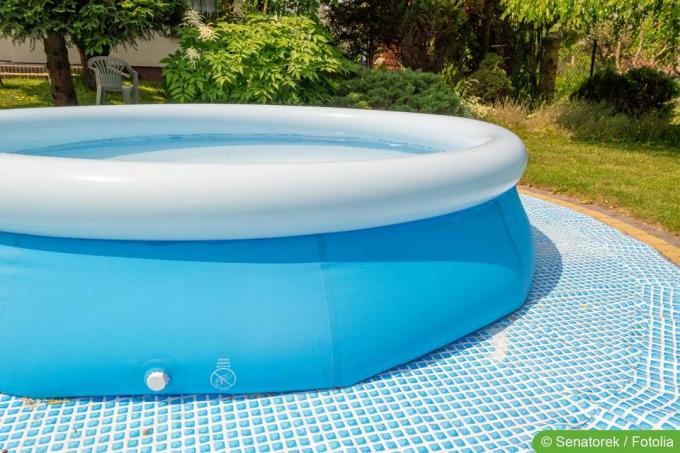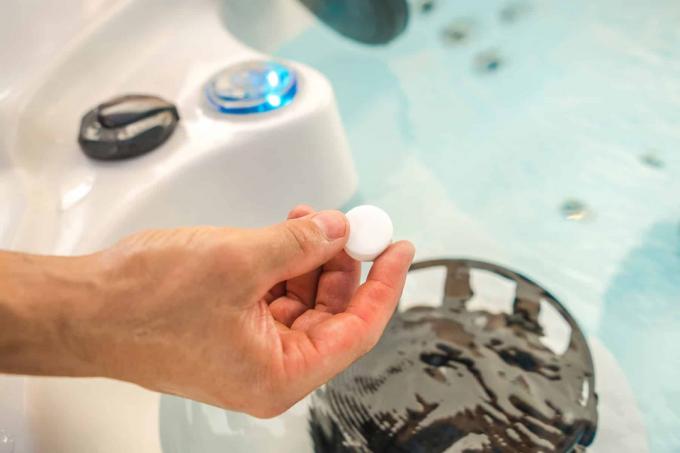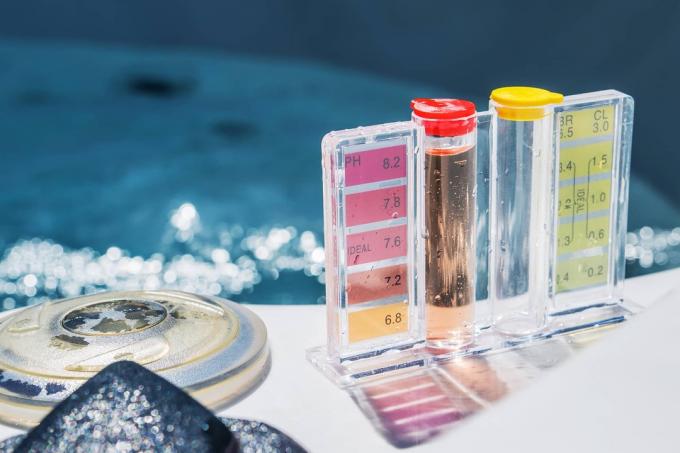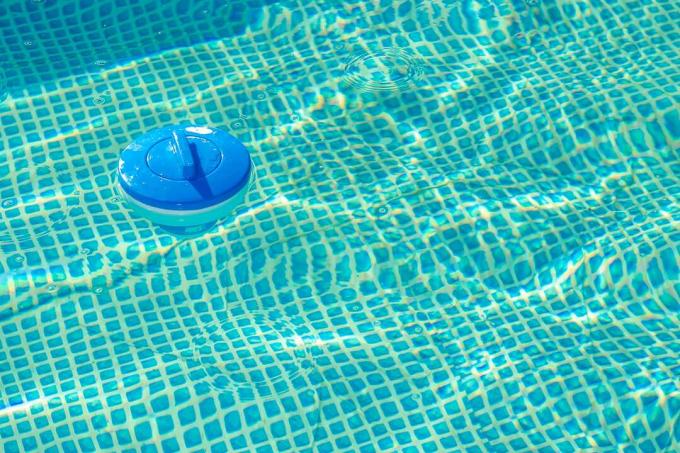

Table of contents
- Advantages of quartz sand
- Disadvantages of sand
- Create a pool substructure made of quartz sand
- dig foundation
- Tools & Material
- Instructions
- When can quartz sand be used as a substrate?
Many places recommend using sand as a pool substructure or substrate. But what are the advantages and potential disadvantages? These and other questions are answered comprehensively in our guide.
Advantages of quartz sand
Using sand for the substructure of a pool has several advantages, which is why the material is used with pleasure and often. The plus points are:
- easy leveling of uneven spots
- suitable for larger areas
- low cost
- variable use
- little effort when deploying
Disadvantages of sand
The biggest potential downside to using silica sand for a pool deck is that the pool can slip and the silica sand can spread. This in turn can cause bumps again. The only decisive factor in preventing this problem is the correct procedure when spreading the sand.
Create a pool substructure made of quartz sand
Using a layer of sand as a base for the pool is possible in just a few steps. Two different variants are possible. The simplest option is to only use sand for leveling.

Bigger holes
These will be filled first. Coarse gravel or crushed stone can be used for this. It is also possible to adjust the unevenness with soil.
removal
As well as holes or troughs, foreign objects and other unevenness such as stones, roots and hills must also be removed. Raised areas are to be removed and adjusted.
compacting
The soil should be compacted to create an even and firm subsoil. It can also be noticed whether, for example, foreign objects or stones have been overlooked. Because these are not only harmful to the bottom of the pool, but can also cause pain when standing in it.
control
Before the quartz sand is applied, the surface should be checked completely. A height difference of one percent to a maximum of three percent is ideal. This means that a height difference of one to three centimeters should not be exceeded over a meter in length. Otherwise the pool will later be crooked and may overflow or become damaged.
spread sand
As soon as the preparations are complete, the quartz sand can be spread. This evens out any small bumps that may still exist and serves as a kind of buffer between the underground and the bottom of the pool. Before setting up the swimming pool, however, it is important to level and smooth the sand. A vibrating plate or flat vibrator can be used for this. However, smoothing can also be done with a board.
Tip:
Laying a weed fleece under the sand prevents roots and plants from growing through. This can also prevent damage to the pool.
dig foundation
The second way to make a substructure out of sand is to first dig a foundation. The effort is initially greater, but this is also the more stable and durable variant. In the medium and long term, this even reduces the need for work.
Tools & Material
- Flat vibrator or plate vibrator
- gravel
- mini excavator
- piles
- quartz sand
- line
- gravel
- spade
- level

Instructions
1. Mark out
After the outline of the pool has been measured, the perimeter is staked out. This is where the stakes and cord come into play. This demarcation serves as a guide for the subsequent excavation of the earth.
2. excavation
Depending on the size of the area, a spade may be sufficient, or a mini excavator may be a better choice. The pit should be 20 to 30 centimeters deep. The blade length of a spade can be used as a guide.
3. compacting
Flat vibrators or vibrating plates should be used to create a stable base and level the ground.
4. Check
A spirit level is a quick and easy way to check whether the surface has been prepared appropriately was or, if necessary, still be improved and filled up or removed in some places must.
5. weed fleece
If the ground is firm and level, weed fleece can be laid out. This prevents roots or unwanted growth from breaking through and damaging the pool.
6. Fill up
The first quarter of the filling should be coarse crushed stone. Another quarter is made up of finer gravel. These layers are also compacted after filling.
7. admit sand
Quartz sand is used for filling, which should also only make up a quarter of the depth of the pit. After renewed compaction, the pool can be erected.
8. Adjust margins
When the pool has been constructed, the space between the bottom edges of the pool and the foundation should also be filled with sand. This serves as a buffer, which can prove to be extremely practical when moving in the water. Another advantage of this variant is that the swimming pool is given additional stability.
A notice:
Renting a vibrating plate or a flat vibrator is easily possible at many hardware stores. Renting a mini excavator is also recommended for larger areas.
When can quartz sand be used as a substrate?
Quartz sand in combination with a foundation is always suitable as a substructure for a pool when it comes to:
- is an above-ground model
- there is no level ground
- a gap needs to be leveled out
- the pool is very big
The selection of quartz sand, on the other hand, is independent of the decision to set it up. Even with an in-ground pool, the material in the substructure can be a very important component. This applies even if the substructure of the pool has been concreted.
A layer of sand is therefore suitable in any case, from the small paddling pool for the little ones to the large pool for the whole family. If it is a model with a plastic or metal frame, just a few centimeters are sufficient as a stabilizing foundation. This makes it easier to set up and dismantle the pool and still offers a good footing.
In addition, the foundation prevents the subsoil from shifting. These are decisive advantages, especially for children and use by several people.
Tip:
For very small, light pools, a depth of 20 centimeters is sufficient and there is no need for gravel. A filled layer of quartz sand then acts as a buffer under the floor and can also ensure distance and safety at the edge of the pool used.
 Home editorial office
Home editorial office
Learn more about water in the garden

How quickly does chlorine break down?
How quickly chlorine breaks down in pool water is important information for a number of reasons. It is important to know which factors play a decisive role in the degradation rate. This guide shows which influences are decisive.

Too much chlorine in the pool: what to do?
If too much chlorine accidentally ends up in the pool or the chlorine value is inexplicably high, there are several measures you can take. This guide shows what can quickly and sustainably help and reduce the chlorine content.

Too much chlorine in the pool: swim anyway?
If too much chlorine has ended up in the pool, the question immediately arises as to whether bathing is still possible. What risks can this entail and what are the warning signs? Here are the answers.

Reducing chlorine levels in the pool: chlorine levels explained
Is the chlorine level in the pool too high and bathing is not possible? Then good advice does not have to be expensive, because the chlorine values can be easily reduced in several ways and thus brought into the optimal range.

Pool initial filling: initial chlorination dosage
When the pool is about to be filled for the first time, the question of initial chlorination also arises. When and how is it carried out and what dosage is correct. This guide shows step by step how to do it.

How much chlorine in 1,000 liters of water?
Chlorine can keep pool water clear or, as shock chlorination, remove cloudiness and green discoloration. The question of how the right dosage and the optimal values look like arises again and again. This guide provides comprehensive answers.

